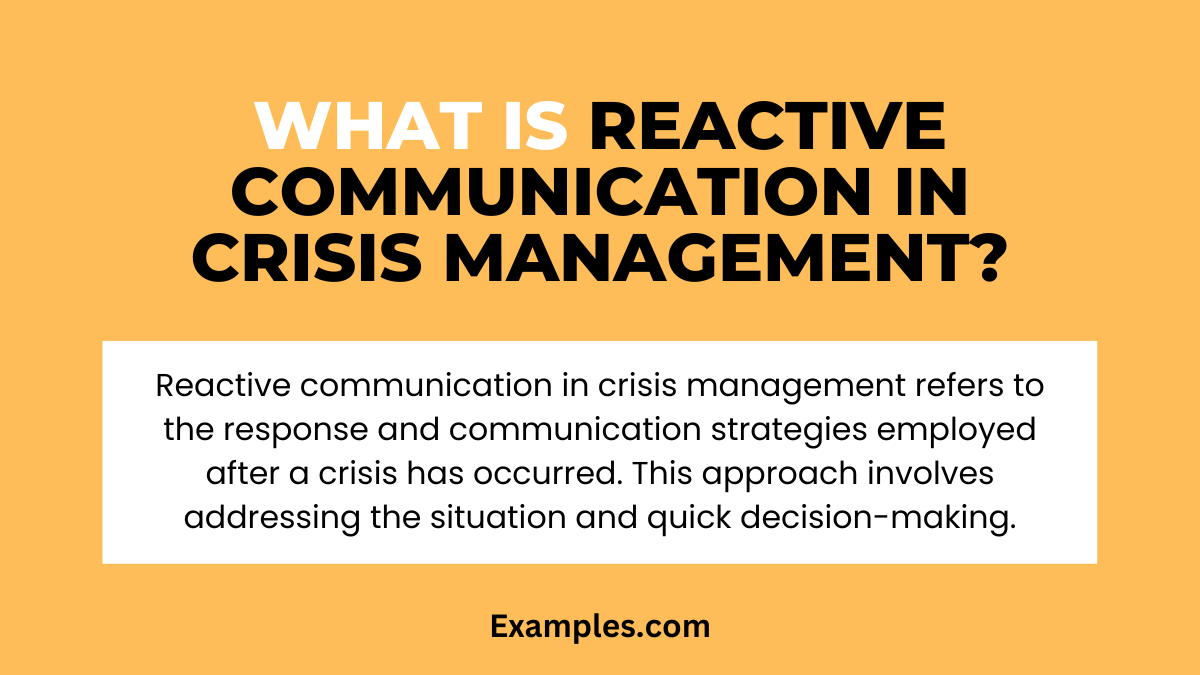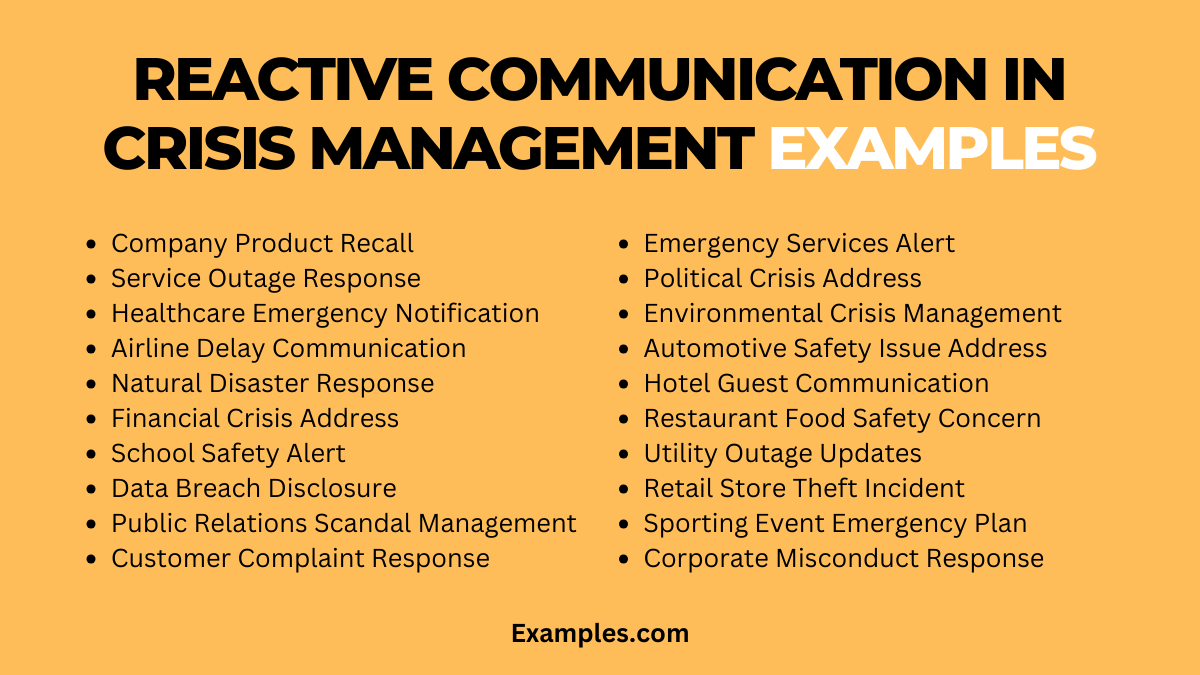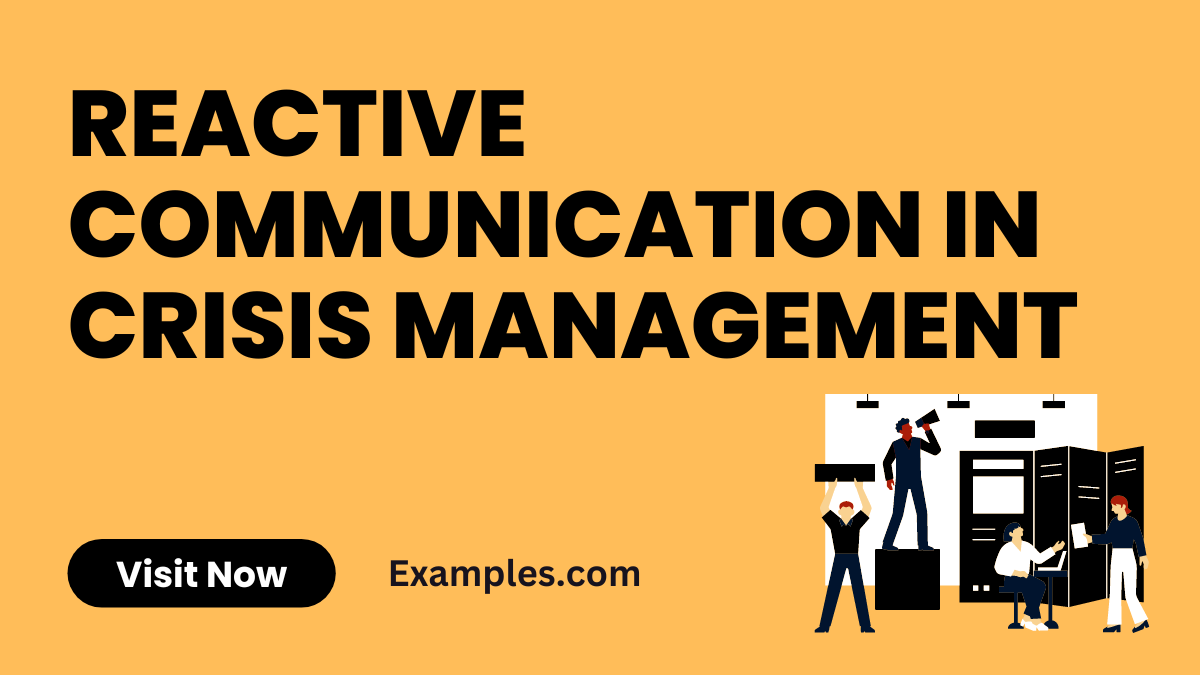19+ Reactive Communication in Crisis Management Examples
Reactive communication in crisis management focuses on responding to crises after they occur. This guide will explore effective strategies and communication examples showcasing how organizations can manage unexpected challenges. Emphasizing transparency, timeliness, and accuracy, reactive communication plays a crucial role in addressing stakeholders’ concerns and restoring normalcy. It involves crisis assessment, formulating appropriate responses, and engaging with affected parties. Understanding reactive communication is vital for any crisis management plan to effectively navigate through and recover from unforeseen events.
What is Reactive Communication in Crisis Management?

Reactive communication in crisis management refers to the response and communication strategies employed after a crisis has occurred. This approach involves addressing the situation as it unfolds, often requiring quick decision-making and real-time updates to stakeholders. It’s characterized by immediate reaction to events, crisis containment, and efforts to minimize damage. Reactive communication is crucial for effectively managing unforeseen situations and maintaining public trust during and after a crisis.
What is the Best Example of Reactive Communication in Crisis Management?
Reactive communication is best exemplified in scenarios where an organization or individual responds to an unexpected crisis or event. A classic example is a company addressing a sudden public relations issue. The company may not have anticipated the crisis, but it quickly formulates a response to the emerging situation, often involving public statements, press releases, or social media engagement. This response is aimed at controlling damage, clarifying misunderstandings, and maintaining public trust.
20 Reactive Communication in Crisis Management Examples

Reactive communication is a critical component in crisis management. It involves responding to events after they have occurred, addressing concerns, and providing information to manage the situation effectively. This strategy is often utilized when unforeseen circumstances arise, necessitating immediate action and clear communication to stakeholders.
- Company Product Recall: After discovering a product flaw, a company issued a public recall. They provided clear instructions for returns and replacements, effectively managing customer concerns and maintaining trust.
- Service Outage Response: A tech company experienced a service outage. They promptly informed users via social media and email, explaining the issue and expected resolution time.
- Healthcare Emergency Notification: During a hospital emergency, staff used intercom announcements and digital displays to instruct patients and visitors, ensuring safety and calm.
- Airline Delay Communication: An airline faced significant flight delays. They used their mobile app and announcements to update passengers on new timings and provided accommodation options.
- Natural Disaster Response: In response to a natural disaster, a local government issued statements through various media outlets, providing safety guidelines and evacuation routes.
- Financial Crisis Address: During a financial crisis, a bank communicated with its customers via email and social media, assuring them of the safety of their deposits and available support.
- School Safety Alert: A school quickly communicated with parents through text alerts regarding an on-campus incident, ensuring the children’s safety and calming worried parents.
- Data Breach Disclosure: After a data breach, a company immediately informed affected customers, outlining the steps taken to secure data and offering credit monitoring services.
- Public Relations Scandal Management: A celebrity managed a public relations scandal by issuing a sincere public apology and taking responsibility for their actions.
- Customer Complaint Response: A retail store addressed a surge in customer complaints by promptly replying on social media, acknowledging issues, and offering solutions.
- Emergency Services Alert: Emergency services used radio broadcasts to inform the public about a severe weather warning and necessary precautions.
- Political Crisis Address: A government official addressed a political crisis with a televised speech, clarifying their stance and steps to resolve the issue.
- Environmental Crisis Management: A company facing an environmental crisis due to an oil spill communicated their clean-up plan and ongoing environmental restoration efforts.
- Automotive Safety Issue Address: An automotive company addressed a safety issue in their vehicles by sending out notices to owners and scheduling free repairs.
- Hotel Guest Communication During Power Outage: During a power outage, a hotel communicated with guests using emergency lighting and staff assistance, ensuring comfort and safety.
- Restaurant Food Safety Concern: After a food safety concern, a restaurant communicated with the public about their enhanced safety measures and health inspections.
- Utility Outage Updates: A utility company provided regular updates via social media and text messages during an extended power outage, informing customers about restoration efforts.
- Retail Store Theft Incident: After a theft incident, a retail store communicated with customers about increased security measures and cooperation with law enforcement.
- Sporting Event Emergency Plan: During a major sporting event, organizers used public address systems to communicate an emergency evacuation plan due to a threat.
- Corporate Misconduct Response: A corporation responded to allegations of misconduct by issuing a statement of commitment to ethical practices and outlining steps for improvement.
What are the Reactive Communication Strategies in Crisis Management?
Reactive communication strategies in crisis management focus on responding effectively after a crisis has occurred. Key strategies include:
- Rapid Response: Quickly acknowledging a crisis is crucial for controlling the narrative. A prompt response prevents misinformation and demonstrates that the organization is handling the situation responsibly.
- Accurate Information: Providing factual, updated information as events unfold is essential. It helps in maintaining credibility and trust among stakeholders.
- Stakeholder Engagement: Active communication with all affected parties, including customers, employees, and the media, is vital. It ensures that everyone receives timely and accurate information.
- Consistent Messaging: Consistency across various communication channels is key to avoid confusion. It helps in reinforcing the message and maintaining a unified front.
- Media Management: Managing media relations effectively is crucial in shaping public perception. Timely and accurate press releases and briefings can help in managing the narrative.
- Empathy and Transparency: Demonstrating understanding and openness about the situation is important. It shows that the organization is not just managing the crisis, but also caring about its impact on people.
How to Write Reactive Communication Plan in Crisis Management?
Creating a reactive communication plan involves:
- Situation Analysis: Conduct a thorough assessment of the crisis to understand its nature and impact. This analysis guides the communication strategy.
- Audience Identification: Identify key audiences affected by the crisis. Tailor your communication to address their specific concerns and needs.
- Message Development: Develop clear, concise messages that are relevant to each audience segment. Ensure the messages address the key aspects of the crisis.
- Channel Selection: Choose the most effective channels for reaching your audiences. This could include social media, press releases, or direct communication.
- Role Assignment: Clearly define the roles and responsibilities within the crisis management team. This ensures efficient and coordinated communication efforts.
- Monitoring and Adapting: Continuously monitor the situation and public response. Be prepared to adapt your messages as the situation evolves.
- Post-Crisis Review: After the crisis, conduct a review of the communication efforts. Analyze what worked well and identify areas for improvement. This review is crucial for refining future crisis communication strategies.
Tips for Improving Reactive Communication in Crisis Management
Here are Tips for Improving Reactive Communication in Crisis Management:
- Quick Situation Assessment: Rapidly evaluate the crisis to understand its scope and impact. Quick assessments allow for more timely and relevant responses.
- Clear Communication Channels: Ensure that all communication channels, such as email, social media, and press releases, are open and functioning. Clear channels prevent misinformation and delays.
- Accurate Information Dissemination: Regularly update stakeholders with accurate, verified information. Accuracy builds trust and credibility during a crisis.
- Stakeholder Prioritization: Identify which stakeholders are most affected and address their specific concerns first. Prioritizing helps in managing the crisis effectively.
- Feedback Incorporation: Use feedback from stakeholders to adjust and improve your communication approach. This ensures that your strategy remains effective.
- Post-Crisis Analysis: After the crisis, analyze the effectiveness of your communication. Learn from successes and mistakes to enhance future crisis responses.
- Crisis Simulation Drills: Conduct regular drills to test and improve your reactive communication strategies. Drills help in identifying weaknesses and areas for improvement.
Reactive communication in crisis management is essential for organizations to effectively manage unforeseen challenges. It involves responding promptly to crises, often requiring immediate action to mitigate impact. This approach ensures stakeholders are kept informed and helps maintain trust during turbulent times. Essential in maintaining an organization’s integrity, reactive communication is a key pillar in comprehensive crisis management strategies.



